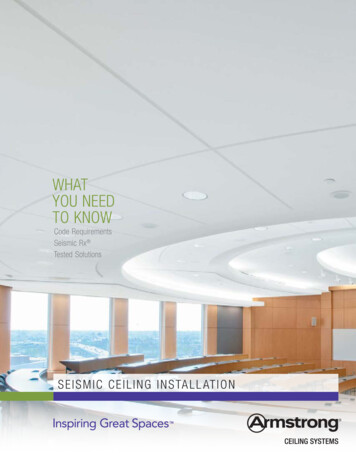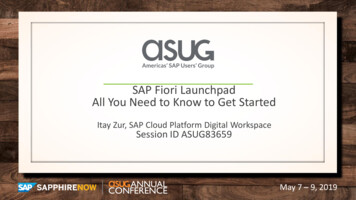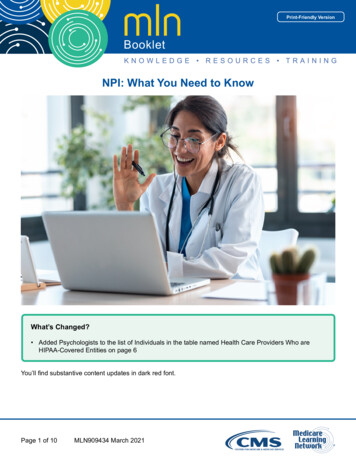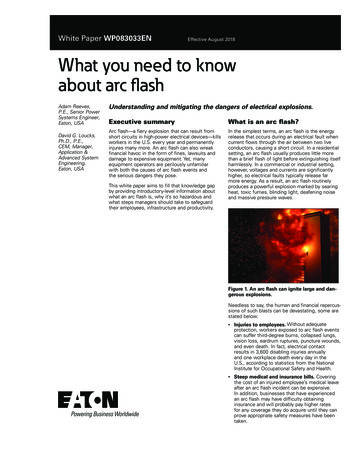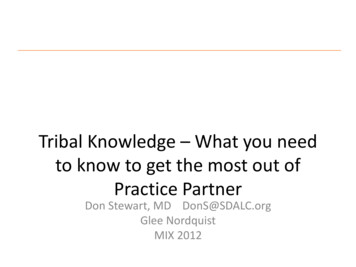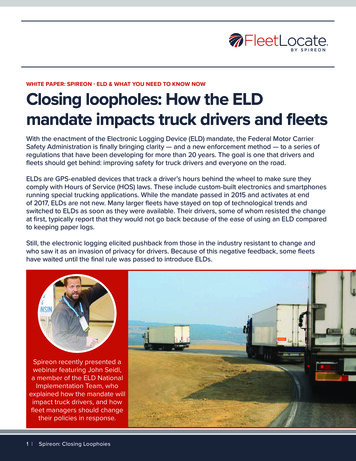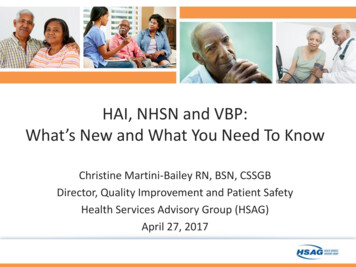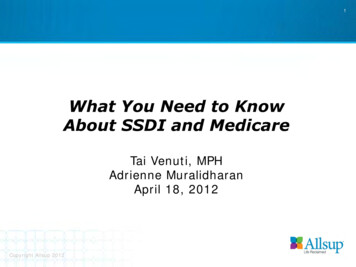
Transcription
1What You Need to KnowAbout SSDI and MedicareTai Venuti, MPHAdrienne MuralidharanApril 18, 2012Copyright Allsup 2012
WelcomeToday we’ll cover:– History of SSDI– SSDI process Evaluating spinal/musculoskeletal claims Awards for individuals and dependents When you should apply– Getting help with your SSDI claim– How Medicare works– Who’s eligible for Medicare– What you need to do– Where to go with questionsCopyright Allsup 20122
Social Security Disability Insurance Established in August 1956. Payroll tax-funded (FICA taxes), federal insurance program.Provides income to people unable to work because of a disability. To qualify for SSDI benefits, you must be both “currently insured”and “fully insured”—that is you have earned 20 “work credits” inthe last 10 years. You earn a credit for every 1,130 in earnings, and you need 4,520 to get the maximum four credits for the year. Usually, ifyou have worked five out of the last 10 years you are currentlyinsured. If you are under age 31 when you become disabled, it is possibleto be currently insured with less than 20 quarters of coverage. SSDI is not “means-based.”Copyright Allsup 20123
Benefits of SSDI Monthly Income: A regular monthly payment based onyour lifetime earnings, adjusted annually for cost-of-living. Aportion may be tax-free. Medical Benefits: 24 months after date of your cash SSDIentitlement, you qualify for Medicare. This includes MedicareAdvantage, usually a better option for those with disabilities. Drug Coverage: Medicare coverage includes Part D. COBRA Extension: If you receive SSDI, you could extendyour COBRA benefit coverage an additional 11 months.Copyright Allsup 20124
Benefits of SSDI Protected Retirement Benefits: SSDI “freezes” yourSocial Security earnings record during the disability period.These years aren’t counted when computing futurebenefits, so your retirement benefit could be higher. Return-to-Work Incentives: Social Security will provideopportunities to return to work while still paying yourdisability benefits. Protecting other income benefits: Most long-termdisability (LTD) policies require claimants to apply forSSDI. If you do not, your LTD benefits are oftensuspended, resulting in a reduction in income. Dependent SSDI Coverage: If you receive SSDI andhave a dependent under age 18, he or she also mayreceive benefits.Copyright Allsup 20125
Supplemental Security Income Supplemental Security Income (SSI) is a means-basedprogram. Provides monthly income to people who are 65 or older,disabled, or blind (including children under 18) and havelittle/no work history. Funded through general tax revenues. Must meet SSA’s disability criteria AND have limitedincome and resources (needs-based).Copyright Allsup 20126
SSDI EligibilityThe SSA defines a person as disabled if:– A physical or mental impairment prevents you from engagingin any substantial gainful work.– Your condition is expected to last 12 months or longer orresult in death.To qualify:– You meet the criteria above.– You have worked (and paid FICA taxes) 5 out of the last 10years.– You have not reached retirement age (65-67). Over 21 years of age and less than retirement age.– You have medical proof of disability.Copyright Allsup 20127
Determining Disability for SSDISSA follows a Sequential Evaluation– First, are you working and earning less than 1,010/month?– Second, are you unable to do activities related to work?– Third, does your disability meet a medical listing?– Fourth, can you perform your previous job?– Finally, does age, education, training and work experienceallow you to do another job?Copyright Allsup 20128
What is the SSDI Process?Consists of five (5) levels within application process.Copyright Allsup 20129
Level 1 – Initial Application Application completed by claimant with SSA district office (or withrepresentative). Mandatory wait period for benefits is 5 months after dateof onset. District office prepares evidence for state-level DisabilityDetermination Services (DDS). DDS compiles medical evidence, sends questionnaire, ordersconsultative exam. DDS determines if claimant should be awarded or denied. SSA reports time at this level 109 days in 2011. Approximately 66% of claims are denied at this level.Copyright Allsup 201210
Level 2 – Reconsideration If claimant is not awarded at first level, seeks appeal withthe SSA District Office. Claimant has 60 days to file and submit an appeal. District Office submits evidence to DDS. DDS compiles medical evidence, sends questionnaire,orders consultative exam. DDS determines if claimant should be awarded or denied. Reconsideration level typically takes 3-5 months. Approximately 88% of claims are denied at this level.Copyright Allsup 201211
“Skip”/Redesign States New SSA policy adopted in 1999 that enables claimant toskip the “reconsideration” and move straight to the hearing. Two offices in California (LA N 00057 and LA W 00056). “Skip states” include AL, AK, CO, LA, MI,MO, NH, NY, PA.Copyright Allsup 201212
Level 3 – Hearing with ALJ Claimant files appeal with SSA District Office. District Office forwards request to Office of Disability,Adjudication and Review (ODAR). Administrative law judge (ALJ) determines if claim can beawarded on the record or if it requires hearing. If hearing required, (ALJ) conducts hearing with claimant. Typically takes 14 months to get to hearing, decisiontypically reached @ 360 days in 2011 according to SSA. Estimated to be 326 days in 2012. Approximately 42% of claims are denied at this level.Copyright Allsup 201213
Level 4 – Appeals Council14 Claimant files appeal with Appeals Council. District Office forwards file to Appeals Council for review. Typically lasts about one year; SSA reports 358 days at thislevel in 2011. Estimated to be about 340 days in 2012. Appeals Council awards, remands or affirms ALJ’s denial.– Remands case should be reviewed again by ALJ.– Awarded moves forward in process.– Approximately 98% are denied.Copyright Allsup 2012
Level 5 – Federal District Court Requires formalrepresentation by attorneywho will file civil suit inFederal District Court. Typically lasts 12 months. 98% of claims aredenied at this level.Copyright Allsup 201215
SSDI AwardIf your claim is awarded, on average:– You could receive a retroactive payment, dated back to youronset date 5 month waiting period. Example, date of onset of1/15/11 would result in retro benefits paid back to 7/1/11.– Monthly awards usually begin within two to four weeks afternotification for claims awarded at Application orReconsideration levels.– Awards typically begin one to three months after notificationfor claims awarded at Hearing or Appeals Council levels.– Large retroactive payments may be paid out in incrementsover several months.Copyright Allsup 201216
SSDI AwardHow much will you get? Your award is determined by a complicated formula using yourpast earnings that have been subjected to FICA taxes. The average monthly benefit for an individual was 1,072 in2011. A disabled worker with dependents averaged 1,826 permonth.Medicare entitlement After a 24-month waiting period from when cash SSDI benefitsbegin.Continuing Disability Reviews Conducted every 1, 3, 5 or 7 years, incumbent upon the conditionand possibility of improvement.Copyright Allsup 201217
SSDI and DependentsDependent SSDI Coverage– Someone who receives SSDI and has dependents under age18 may be able to receive dependent benefits.– SSA sets a total household award amount. Dependents can receive up to one-half of the parent’s totalaward. Example: parent receives 1,000 a month.– Total household amount: 1,500– One child: 500; two children: 250 each If more than one parent is disabled, SSA calculatesdependent award using the parent with the higher monthlyaward.Copyright Allsup 201218
When Should You Apply? As soon as you know you have a severe, long-termdisability that will keep you from working12 months orlonger, or is terminal. You may know you have a long-term disability before 12months have passed. Apply right away—you don’t need towait to apply. There are a number of ways to confirm that a disability islong term, including a doctor’s diagnosis and medicalevidence of a chronic condition or disease. Talk to others who have been through the process.Copyright Allsup 201219
Why people need help More individuals applyingfor SSDI. Fewer resources at SSA tohandle incoming requests. Process is complicated andintimidating. Most individuals do nothave enough savings/income to sustain themthrough the months- toyears-long process. Nearly 30% denied fortechnical reasons. About 80% of individualshave representation at thehearing level.Copyright Allsup 20122020
Getting Help With SSDI“If claimants .had representatives earlierin the disability process, some of themmay have received an allowance decisionat the DDS level, saving them time andSSA money.First, the claimants may not have had togo to the hearing level if they hadrepresentatives to assist them withcompleting SSA’s forms and providing thenecessary evidence at the DDS level.This could have saved some claimantsabout 500 days in receiving an allowancedecision.”Disability Impairments on Cases Most Frequently Denied by Disability Determination Services and Subsequently Allowed by Administrative Law Judges, August .pdfCopyright Allsup 201221
Spinal disorder denials/awardsDisability Impairments on Cases Most Frequently Denied by Disability Determination Services and SubsequentlyAllowed by Administrative Law Judges, August 2010. opyright Allsup 201222
2323How much does it cost? Fees regulated by the federal governmentand are contingency based (if Allsup isunsuccessful, individual pays nothing). Flat fee if awarded at level 1 (Allsup’shigh success rate at this level meansmany clients pay the flat rate) OR 25% of retro payment if claim goesthrough appeal process---capped at 6,000. Allsup does not charge for out-of-pocketexpenses---copying medical records,phone calls, travel, etc.Copyright Allsup 2012
24Allsup.com SSDI information,personal stories,eligibility checklist Resource Center Allsup Place Allsup MedicareAdvisor Disability LifePlanning Service Financial planningcalculatorsCopyright Allsup 2012
What Is Medicare? A health insurance program for people:– 65 years of age and older– Under age 65 with certain disabilities– With End-Stage Renal Disease (ESRD) Administered by the Centers for Medicare& Medicaid Services (CMS). Enrollment– Social Security (SSA)– Railroad Retirement Board (RRB)Copyright Allsup 201225
Applying for Medicare Apply 3 months before age 65.– Don’t have to be retired.– If your spouse has worked but you have not, you can still beeligible for Medicare when your spouse turns 65 and joins.– Contact the Social Security Administration. Enrollment automatic if receiving:– Social Security– Railroad Retirement benefits5/4/2012Copyright Allsup 201226
Medicare Coverage Basics PartPartPartPartCopyright Allsup 2012A (Hospital Insurance)B (Medical Insurance)C (Medicare Advantage Plan)D (Medicare Prescription Drug Coverage)27
Medicare ChoicesTwo paths:1.Keep Original Medicare and add Medicare Part D with orwithout a Medigap plan.2.Get Medicare Advantage.Copyright Allsup 201228
Original or Traditional Medicare –Medicare Parts A and BPart A helps pay for: Hospital inpatientcare Skilled nursingfacility (SNF) care Home healthcare Hospice care BloodCopyright Allsup 2012Part B helps pay for: Doctors’ services Outpatientmedical/surgicalsvcs & supplies Diagnostic tests Outpatient therapy Outpatient mentalhealth services Some preventivehealthcare services Other medicalservices29
30Cost of Original Medicare Most people receive Part A premium free. People who pay for Medicare Part B typically pay 99.90per month in 2012, but may pay more if they have higherincome:File Individual Tax ReturnFile Joint Tax ReturnYou Pay the following forPart B 85,000 or below 170,000 or below 99.90 85,001 - 107,000 170,001 - 214,000 139.90 107,001 - 160,001 214,001 - 320,000 199.80 160,001 - 214,000 320,001 - 428,000 259.70Above 214,000Above 428,000 319.70Copyright Allsup 2012
Other Costs Associated with OriginalMedicare Deductibles (the amount you must pay before Medicarebegins paying for your medical services).– Part A: 1,156 per benefit period– Part B: 140 per year Copayments/coinsurance (a flat fee or percentage you payat the time you receive services).– Varies by serviceCopyright Allsup 201231
Enrolling in Medicare Part B Automatic Enrollment– Must opt out if not wanted (can do so without penalty if youhave coverage already). Initial Enrollment Period (IEP)– 7 months starting 3 months before month of eligibility. General Enrollment Period (GEP)– January 1 through March 31 each year– Coverage effective July 1– Premium penalty 10% for each 12-month period eligiblebut not enrolled. Paid for as long as the person has Part B. Limited exceptions.Copyright Allsup 201232
How Original Medicare Works With Original Medicare, you can:– See any provider who takes Medicare, instead of sticking to aplan’s network.– Use your coverage anywhere in the United States. But remember:– If you decide to keep Original Medicare, you should seriouslyconsider getting a drug plan since Original Medicare does nottypically cover drugs; you may also want to get a Medigapplan if you visit the doctor frequently or would prefer to payvery little at the doctor but don’t mind paying more inpremiums.– The deductibles and copayments with Original Medicare canbe high.– You’ll have more than one card when you go to thepharmacy---your Medicare card and your drug plan card.Copyright Allsup 201233
The Medicare CardJane DoeCopyright Allsup 201234
Medigap Health insurance policy––––Sold by private insurance companies.Costs vary by plan, company and location.Must say “Medicare Supplement Insurance.”Covers “gaps” in Original Medicare. Deductibles, coinsurance, copayments. Does not work with Medicare Advantage Plans.– Up to 10 standardized plans A – D, F, G, K, L, M, N – Except inMassachusetts, Minnesota and Wisconsin.Copyright Allsup 201235
How Medigap Works People can buy a Medigap policy–Within 6 months of enrolling in Part B.–If they lose certain kinds of health coverage through no fault oftheir own.–If they leave Medicare Advantage Plan under certaincircumstances.–Whenever the company will sell them one.Medigap has to meet certain federal requirements, but isgenerally ruled by the state. Not all states require thatMedigap plans be available to people under 65.Copyright Allsup 201236
What Medigap CoversCopyright Allsup 201237
Medicare Advantage (MA) Plans Health Maintenance Organization (HMO) PlansPreferred Provider Organization (PPO) PlansPrivate Fee-for-Service (PFFS) PlansSpecial Needs PlansCopyright Allsup 201238
What’s Covered by Medicare AdvantagePlans All Part A and B services through plan––––May have to use providers in plan’s network.Benefits and cost sharing may differ from Original Medicare.Generally must still pay Part B premium.Prescription drug coverage. May get extra benefits– Vision, hearing, dental services. Still in Medicare program– Get all Part A and Part B services.– Have Medicare rights and protections.Copyright Allsup 201239
Medicare Part D - Prescription DrugCoverage Completely unlike most other insurance.– Has a donut hole– Many, many plan choices Available to all people with Medicare.Provided through private insurance plans for an additionalpremium.Copyright Allsup 201240
How Prescription Drug Plans WorkIn 2012, you’ll pay: Deductible of 320, if applicable. 25% until your costs reach 2,930. 50% on brand-name drugs; 86%on generics until your costs, yourplan’s costs and the amount ofyour discounts reach 4,700. 5% until the end of the year, nomatter how much your drugs cost.Copyright Allsup 201241
Medicare Part D PremiumsPeople with higher incomes will pay more for MedicarePart D:If your annual income is Add the followingamount to your Part Dpremium:File Individual TaxReturnFile Join Tax Return 85,000 or below 170,000 or below 0 85,000 - 107,000 170,001 - 214,000 11.60 107,001 - 160,000 214,001 - 320,000 29.90 160,001 - 214,000 320,001 - 428,000 48.10Above 214,000Above 428,000 66.40Copyright Allsup 201242
Extra Help With Drug Costs Available for many people with limited income andresources.– Income limit 16,755/year (one person) 22,695/year (married couple)– Resource limit 13,070 (one person) 22,695 (married couple)Copyright Allsup 201244
Recent Changes to Medicare Medicare Part B now covers preventive services with nodeductible, no copay – includes wellness exams andimportant screenings such as medical history, heart healthscreening, mammograms and more. The donut hole is starting to close. Greater emphasis on better plan quality – if you’re in a planwith a quality rating of less than 4.5 stars and have a planin your area with 5 stars, you can consider switching even ifit’s not annual enrollment. Keep in mind, though, that youshouldn’t switch without taking a close look at the coverageavailable first.Copyright Allsup 201245
Things to Remember1.Understanding Medicare is important to ensure you havethe medical and prescription drug coverage that worksbest for your needs.2.Medicare now offers preventive screenings at no cost. Tryto take advantage of these services. Regular checkupsnow can keep you from getting sick later.3.Keeping yourself as healthy as possible with the rightMedicare plan can also help you protect your finances.Copyright Allsup 2012
Things to Consider When will you be 65? Will you keep working? Have you signed up for Medicare?– To do so, call Social Security at (800) 772-1213 or visitwww.socialsecurity.gov Do you have other insurance? Is your insurance part of a retiree or employer benefit? Are any dependents (including a spouse or child) coveredunder your insurance? Will it continue?Copyright Allsup 201247
Confused?If you have questions about Medicare, contactAllsup Medicare Advisor at (888) 271-1173 orwww.ama.allsup.comBe sure to mention the United Spinal Associationfor expedited serviceCopyright Allsup 201248
Questions?49Go to Use.Allsup.Com for a free SSDI evaluationorCall Allsup’s Disability Evaluation Center at(888) 841-2126Be sure to mention the United Spinal Associationfor expedited service.Please log on to to evaluate this presentationCopyright Allsup 2012
entitlement, you qualify for Medicare. This includes Medicare Advantage, usually a better option for those with disabi

